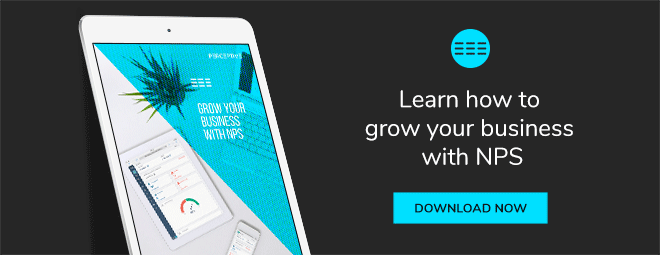Your Net Promoter Score and Voice of Customer programme is intended to gather accurate, useful data. If you are skewing your results, one way or the other, you are producing the opposite. It doesn’t just make it seem like you’re doing better or worse than you are—it could impact your entire customer retention strategy, and not in a good way.
Knowingly or unknowingly, if you want to avoid creating unintentional bias and skewing your NPS results, avoid making these mistakes.
Related content: How do you calculate a Net Promoter Score?
1. Leading questions
An effective email survey is all about accurate, unbiased communication. Your customers will receive an introduction email, the survey itself, and potentially a follow up email—at a minimum. What is said in these emails could influence how customers respond to a significant degree.
What is said in these emails could influence how customers respond to a significant degree.
One example of this is including something like: “Do you think we deserve a high score?”. Asking in this fashion means that you are placing too much significance on the score itself for the customer; simply asking this question so directly could also influence your customer into scoring higher than they otherwise might.
Honest feedback, even if it is negative, is valuable. The above example is extreme, but even subtle changes in word choice or phrasing could impact your survey results. Stay as neutral as possible if you want accuracy.
2. Cherry picking your respondents
You might be cherry picking survey respondents without even knowing it: by selecting customers who are new on the platform, letting your sales or service team hand-select customers, or excluding customers likely to churn.
You might be cherry picking survey respondents without even knowing it.
All of your customers who have the potential to influence the relationship with your company should be included in the contact list. It may be a good idea to have someone who is impartial to the business or process to review the list a final time before deploying the survey.
Read more: What is a good NPS score?
3. Excluding responses
Thinking that customers responses “don’t count” if they perhaps haven’t understood the question at hand may be something that your team are faced with at one point during your survey period.
In this scenario, consider that this can happen to any survey question, and it simply does happen sometimes without your control. Don’t fall into the trap of removing or changing your response scores, regardless of what you may think have happened (someone misunderstanding the intent of the question, historically have rated you a different number or responds “too literally”).
The best thing you can do is to include the score nonetheless and noting your comments down elsewhere to keep this in mind when you read through your comments and conduct your follow-up.

4. Offering financial rewards
A financial reward isn’t necessarily wrong; it depends on how it is being implemented. This subject can be somewhat controversial as some see the compensation as a factor that can influence the score given and potentially hinder authentic feedback.
You can be successful at implementing a reward system, as long as the score given is not based on the reward at hand (i.e. assigning only high scores with a financial reward, or a higher reward based on a higher score – quite simplistic really). For example, if you’re rewarding an employee survey, consider what message you’re sending internally if you tie employee bonuses to a variable target or even pay staff directly for higher scores (yes, this does actually happen).
If you plan on compensating employees based on NPS, take these three steps:
- Assign an impartial agent to administer the survey (such as a third party agent or agency), thereby removing control your end.
- Educate your employees on how to influence scores in an authentic way.
- Establish reliable and recognised metrics for your NPS survey.
5. Educating your respondents
You can actually boost your score unknowingly by just educating your customers on how the Net Promoter works, what the different categories are, and even what the score means.
The more you let your customers know about how NPS works, it means that this will be in the back of their mind as they respond to the survey. This works against you as what you’re aiming for is a spontaneous, top-of-mind response, based on how they feel about your brand. When you let them know about NPS, this can contribute to biased data.
6. Poor timing
Compare two surveys: one is asked just before you start a significant marketing campaign, and one is asked just after. Do you think there could be a difference in the opinions of your customers?
Asking about people's opinions immediately after a significant business move can be an effective way to determine its impact and level of success. But if you only ever ask for opinions at these points, you are not seeing the full spectrum of your customers’ everyday experience. They are only considering your latest advertisement, or your latest product, or your latest office opening, and so on.
Ideally, you’d launch your survey in what’s referred to as a “steady-state” environment: your standard state of affairs with no big events either side: posing a survey after a purchase is fine, but posing a survey after watching a new ad is not. This will ensure you get a more everyday opinion from your customers.
The exception to this rule is when you’d send a touch-point survey, for example onboarding a new customer or gathering feedback from board members.
7. Survey method
You can deploy and monitor your surveys by several means, either online, over the phone, or in-person. Each of these methods can impact responses.
People tend to be more honest (i.e. have a tendency to be more critical), when the survey doesn’t involve face-to-face contact. To avoid a positive skew, you should avoid face-to-face responses for this reason.
Phone surveys can work really well, but unless they’re conducted by an independent interviewer, they can be quite biased as well.
The best method overall is an online survey, for multiple reasons. They are completed behind the safety and anonymity of a computer screen, when the respondent has enough time and is not rushed (usually they are very brief and quick). This allows for the most honest and reliable feedback.
Want to know more about how to leverage your Net Promoter Score? Download our comprehensive eBook to learn more, just click on the button below.
